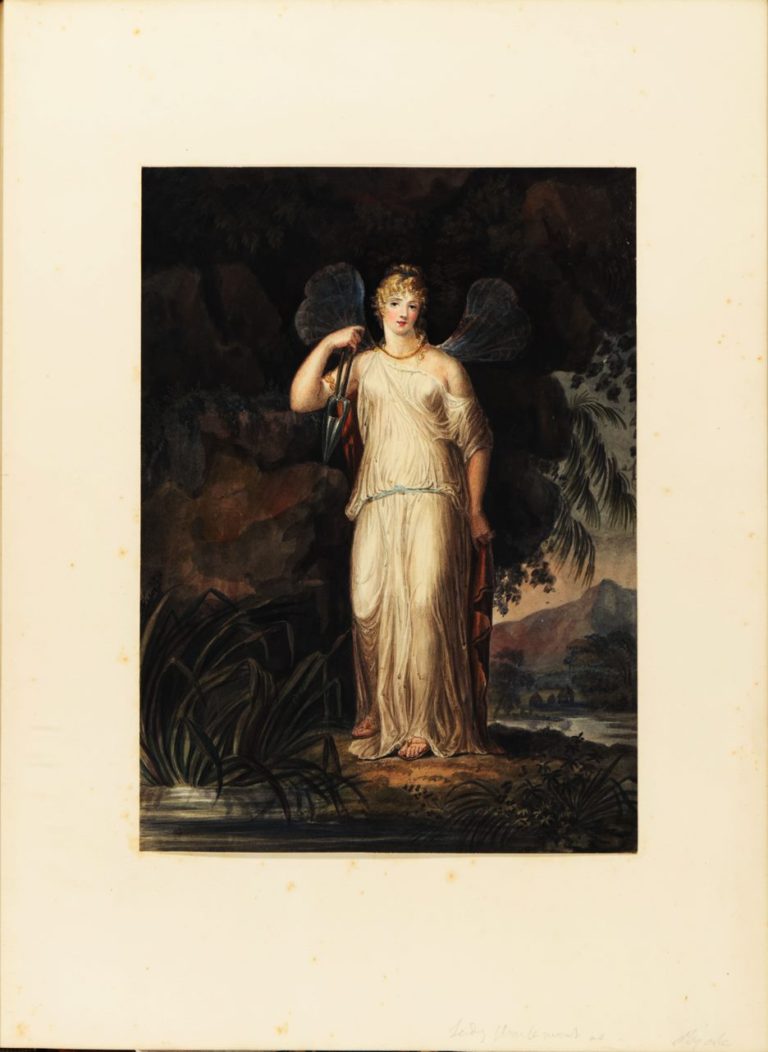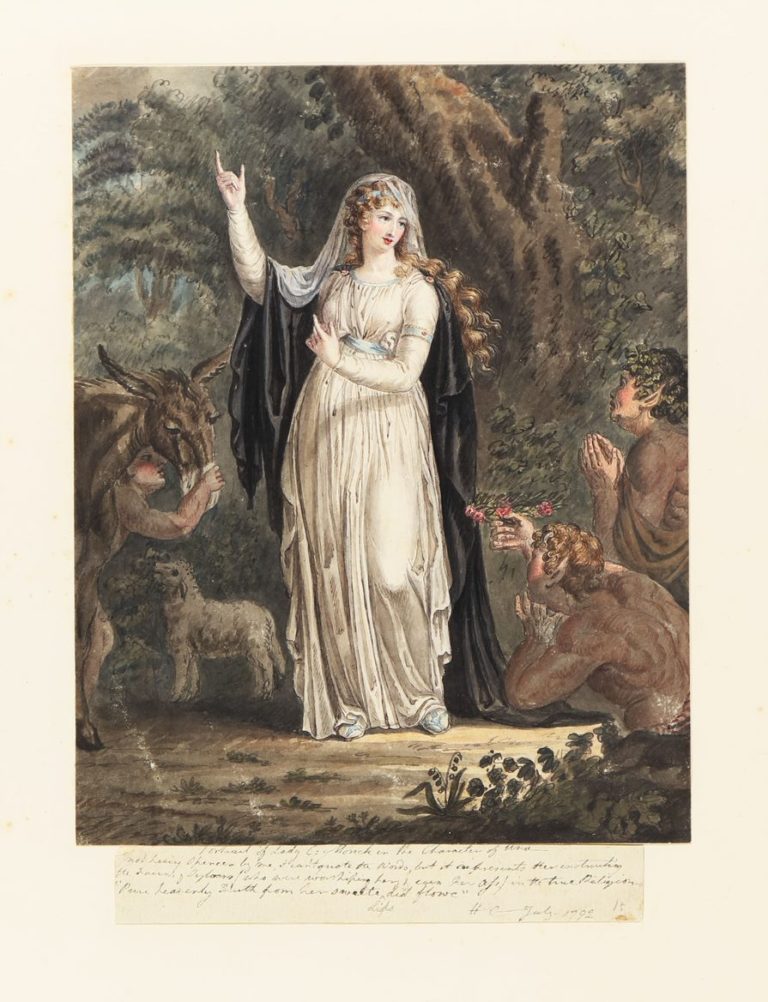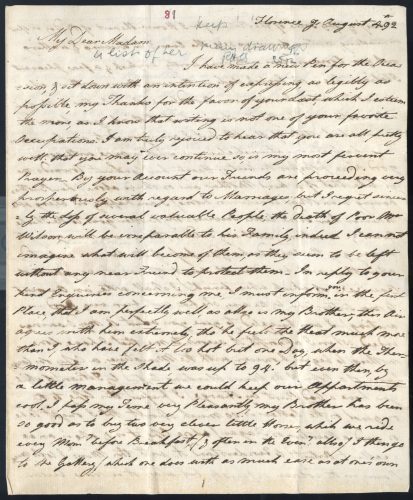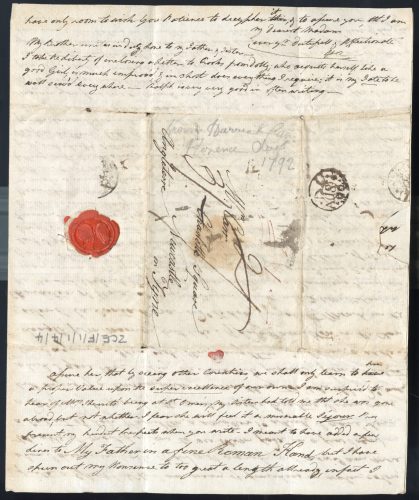Portraits of Lady Elizabeth Monck by Harriet Carr, 1792
Reference: ZCE/F/4/1/3/17 & 18
Suggested age groups: KS2, KS3, KS4, Lifelong Learners
Subject areas: Art, History, Literacy
CONTEXT
During the 18th and 19th century, it was fashionable for wealthy British families to send their sons, and occasionally daughters, on a Grand Tour. This saw privileged young men and women setting off usually from London to travel across Europe. The tourists were affluent enough to spend multiple years on the Tour. They would often carry letters of introduction with them to integrate into society while abroad.
John Carr (1764-1817) and Harriet Carr (1771-1848) were siblings who set out on their Grand Tour in 1791, returning to England in 1794. They were the children of successful northern businessman Ralph Carr and his wife Isabella.
Ralph and Isabella were initially against Harriet going on the Grand Tour but eventually gave their approval because it was thought that the tour would benefit Harriet’s health – she had a cough thought to be tuberculosis. Some of their objections were around fears of the political situation in Europe and potential dangers to travellers. John and Harriet’s ultimate destination was Italy, travelling via France and Switzerland.
John and Harriet spent almost six months in Rome with short trips to Bologna, Florence, Naples, and Turin. They had planned to leave for England in early 1792 but the outbreak of the Franco-Austrian War prevented this. They returned to Florence in May 1792, staying there until November 1793. In December 1793 John and Harriet made a final visit to Rome before leaving for England and arriving home in the summer of 1794.
Writing to her mother from Florence on 4th August 1792 (ZCE F/1/1/4/4/ shown below), Harriet describes her daily routine. Most of her time is taken up by her interest in art.
‘I then go to the Gallery (which one does with as much ease as at one’s own House) & copy some of the Statues for 2 Hours; the rest of the day is spent in reading, writing, drawing’. The Gallery was the Uffizi, one of the must-see sights for the Grand Tourist in Florence, which Harriet used to study and draw both painting and statues.
Harriet goes on to list some of the subjects of her portraits, including Lady Emma Hamilton, Lady Elizabeth Monck and her children, Mrs Fagan and Madam D’Osmond’s children.
Elizabeth Monck is thought to be Lady Elizabeth Arminta Gore (1770-1845) who married Henry Monck. Two portraits of Lady Monck survive amongst the paintings brought home by Harriet.
In both paintings, Elizabeth Monck is depicted as classical figures. In the first she appears as Psyche, the Greek goddess of the soul, in the second she appears as Una, probably a reference to the character in Edmund Spenser’s epic poem The Faerie (Fairy) Queen.
ZCE F/1/1/4/4 Letter from Harriet Carr, Florence, Italy, to her mother Isabella Carr, 4th August 1792.
Harriet describes how she and her brother, John Carr, cope with the hot weather; reports that he has bought ‘two clever little horses which we ride every Morning before Breakfast’; she describes how they spend the rest of their time and looks forward to the festivities to be held during the visit of the Duke and Duchess of Milan; she then lists in detail the drawings and paintings she has made of people she has met in Italy including Lady Emma Hamilton [1765-1815, wife of the British envoy at Naples, Italy, Sir William Hamilton], Lady Elizabeth Monck and the children of Mme d’Ormond as well as copies of paintings in galleries and ‘Ruins’ and she ends by referring to her maid, Dolly, and declares that ‘by seeing other Countries, we shall only learn to put a proper Value upon the super excellence of our own’.
Letter from Harriet Carr, Florence, Italy, to her mother Isabella Carr, 4th August 1792.
Florence August 4th [17]92
My Dear Madam
I have made a new Pen for the Occasion, & sit down with an intention of expressing, as legibly as possible, my Thanks for the favor of your Last, which I esteem the more, as I know that writing is not one of your favorite Occupations. I am truly rejoiced to hear that you are all pretty well; that you may ever continue so, is my most fervent Prayer. By your Account our Friends are proceeding very prosperously with regard to Marriages; but I regret sincerely the Loss of several valuable People; the death of Poor Mr Wilson, will be irreparable to his Family; indeed I cannot imagine what will become of them, as they seem to be left without any near Friend to protect them. In reply to your kind Enquiries concerning me, I must inform you in the first Place, that I am perfectly well, as allso is my Brother; this Air agrees with him extremely, tho’ he feels the Heat much more than I, who have felt it too hot but one Day, when the Thermometer in the shade, was up to 94! but even then, by a little management we could keep our Appartments cool. I pass my Time very Pleasantly, my Brother has been so good as to buy two very clever little Horses, which we ride every Morn[in]g before Breakfast, (& often in the Even[in]g allso). I then go to the Gallery (which one does with as much ease as at one’s own House) & copy some of the Statues for 2 Hours; the rest of the day is spent in reading, writing, drawing, &c &c the Even[in]g in driving & walking out, & in Conversation with some worthy English, & a few pleasant Italians: there is one English Lady in the same House with us, who is a real Treasure; her name is Bowdler, & she is Sister to the Lady who wrote some pretty Treatises, which I think you have; she is in a bad state of Health, but I am rejoiced to see her amending daily; she is extremely clever & what is what is more, with sound good Sense, possesses the best of Hearts; her Conduct towards me is like that of a kind Mother, and as she is alone (her Brother having been oblig’d to return home)I am happy in being able to render her some little Services. My Brother goes to the Theatre, Court, &c sometimes; but I very seldom; tho’ we are now going to be very gay, the Arch Duke & Duchess of Milan, are expected, when there will be Fêtes at Court, Operas, Horse & chariot Races, &c &c of which, when finish’d, I shall write an Account to my Sister;(tho’ by the way, she has not been very good in writing). I am puzzled to give you a List of my Drawings; indeed when I attempt it, seems to me, that I have done nothing: to begin however, with the Miniatures. a Copy on large Ivory, of a Copy of the Venus blinding Cupid, by Titian, (of which you have a bad Print by Strange;) I prefer’d this Copy to the original, as the latter is so much spoilt, that I ought to be as good a Painter as Fagan, (whose Copy it is, & who is an excellent Artist) to understand it: with this Min[iatur]e I took much Pains, in the coloring especially, but alas! it is now become quite a Ghost. (N.B. I am weary of finishing in water-colors; when I drew very badly, it did not signify; but now I am more tolerable, it mortifies me to see them fade in a few days.) a Portrait of Lady Hamilton. a smaller D[itt]o, which I gave her. a D[itt]o of Lady E. Monck (the most angelic Creature I ever saw but dying of a Consumption, or something too like it.) a D[itt]o smaller which I gave her. A Copy (the Face only finish’d) from a Portrait by Fagan. an Idea, Job’s three Daughters. On Paper a whole-Length (from memory, but like) of Lady Hamilton, in the Character of la Santa Rosa. a D[itt]o of Lady Elizabeth Monck, in the Character of Una. a D[itt]o of Mrs fagan, (a pretty modest little Italian) in the Character of Hebe. 2 D[itt]o of Mad[am] D’Osmond’s children (a charming French woman, cousin to
the unfortunate Dillon, & aunt to our Friend E[dward] Swinburne of whom I have spoken before.) 2 D[itt]o of Lady E Monck’s Children. of the[se] Last I gave away the originals & only finish’d the Faces & outlines of t[hose] I kept. several largish Sheets of Outlines, with some Shadow, of the most Beautifull & remarkable Places I have seen: from which, when I return, I mean to make a series of Views. a Book, nearly full, of Ruins, Views, &c. Some finishd but most only outlines. a Book, copies from the antique, &c which I am now filling with the Niobes, Venus, the Wrestlers &c &c &c. 3 small Books, nearly full, but chiefly outlines, of the Customs, & dresses, from London to Naples, from Naples hither; & bits of Landscapes, too pretty to forget, & too insignificant for the larger Books – this is a full Account, & not a large one; when it is remember’d that allmost all are sketches, & most, mere Contours. If, my dear Madam, you find me as much improv’d, as I think yself, (for I seem to “feel my Eyes new opened”, & my mind enlighten’d, as if a Cloud was remov’d from it,) I shall be well contented: for believe me, Madam, that the Pleasure I receive seen, & illustratinge from this Employment, is centuple when I reflect that it is capable of affording you a little Amusement, & I look forward with delight, to describing to you what I have seen, & illustrating my description with my Sketches. I am sorry to hear of Lady Clavering’s Indisposition, I however hope it will not continue, Please to give my Respects to her & assure her, that by seeing other Countries, we shall only learn to put a proper Value upon the super excellence of our own. I am surpris’d to hear of Mrs Skerrit’s being at St Omer’s; my Sister had told me that she was gone abroad, but not whither. I fear she will feel it a miserable Séjour Pray present my kindest Respects, when you write. I meant to have added a few Lines to My Father, in a Roman Hand, but I have spun out my Nonsense to too great a length allready, infact I have only room to wish You Patience to decipher it, & to assure you, that I am my Dearest Madam ever y[ou]r Dutifull & Affectionate H[arriet] C[arr]
My Brother writes in duty & Love to my Father & Sister. I take the Liberty of enclosing a Letter to Crooks from Dolly; who acquits herself like a good Girl, is much improv’d, & in short does everything I require: it is my Fate to be well serv’d every where. Ralph is very very good in often writing
ACTIVITIES
ACTIVITY 1
Background
Writing to her mother from Florence on 4th August 1792 (ZCE F/1/1/4/4/ shown below), Harriet describes her daily routine. Most of her time is taken up by her interest in art.
At the Uffizi, one of the must-see sights for the Grand Tourist in Florence, studied and drew both painting and statues.
Harriet goes on to list some of the subjects of her portraits, including Lady Emma Hamilton, Lady Elizabeth Monck and her children, Mrs Fagan and Madam D’Osmond’s children.
In both paintings, Elizabeth Monck is depicted as classical figures. In the first she appears as Psyche, the Greek goddess of the soul, in the second she appears as Una, probably a reference to the character in Edmund Spenser’s epic poem The Faerie (Fairy) Queen.
SEE
See: Where did Harriet visit in Florence to study and draw paintings and statues?
See: Who were the subjects of some of Harriet’s portraits?
See: Who is thought to be the subject of the paintings shown here?
See: Which two classical figures is Lady Elizabeth Monck depicted as?
THINK
Think: What artistic style has Harriet used to paint the two portraits of Lady Monck?
Think: What influenced Harriet to paint Lady Monck as classical figures?
Think: Why were classical figures depicted in art?
Think: What styles of art were prevalent in Europe during the late 18th century?
Think: How might Harriet’s travels have influenced her art?
Think: What is Neoclassicism?
Think: What was the ‘Enlightenment’ period?
Think: How did the discovery of Pompeii lead to the emergence of the Neoclassic movement?
DO
Do: Read the letter written by Harriet Carr to her mother. Make a list of the artworks and galleries Harriet has visited.
Do: Research one of the artworks, artists or galleries that Harriet mentions in the letter.
Do: Compare your chosen artwork, artist or gallery to the two paintings of Lady Monck. Can you find any stylistic or thematic similarities?
Do: Look at some other examples of letters and artworks composed by Harriet (e.g. ZCE F/1/1/4/1 letter about visiting Mount Vesuvius). Use evidence from the letter to discuss how Harriet’s experiences while travelling might have influenced her artistic choices.
Do: Read Edmund Spenser’s The Faerie Queen.
Do: Choose a character from The Faerie Queen and create a portrait inspired by them.
Do: Create a portrait of a classical God or Goddess.
Do: Come up with your own Neoclassical interpretation of art.
Resources
OTHER ONLINE RESOURCES
British Library page about Edmund Spenser’s The Faerie Queen: https://www.bl.uk/collection-items/the-faerie-queene-by-edmund-spenser-1590#
Tate page about Neoclassicm: https://www.tate.org.uk/art/art-terms/n/neoclassicism
Summary of Neoclassicm: https://www.theartstory.org/movement/neoclassicism/
Podcast about Neoclassical art and the Enlightemnent: https://www.theartstory.org/podcasts/the-enlightenment-and-neoclassical-art.htm






